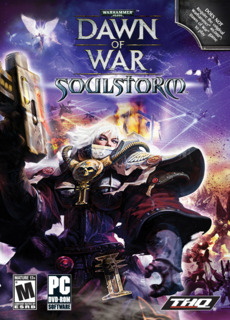What should have been an epic conclusion to this franchise ends up being a lukewarm offering.
To be fair, Soulstorm is not a bad offering all around. For those who are not familiar with the previous installments within the series, notably its predecessor Dark Crusade, the game centers around the perpetual armed conflict set in the Warhammer 40,000 universe, pitting various factions of the Imerium of Man (essentially space Romans with a Medieval catholicity combined with a Third-Reich totalitarianism) against all manner of aliens and heretics. Standing against them are the Eldar, a space-age elder race reminiscent of the Elves; forces of Chaos, represented by men corrupted both physically and mentally by madness and disfiguration; the Necron, essentially Space Undead; the T'au, a technologically advanced race of powersuit-wearing hunters; and the Space Orks, whose name basically speaks for itself. Unlike with most traditional RTS games, Soulstorm almost completely foregoes storytelling in favor of a dynamic campaign which plays out in a fashion very similar to Risk, as the players take turns on the strategic map, conquering territories through real-time battles. Conquest of territories provides players with requisition, which is the game's primary resource. In turn, requisition may be used to reinforce conquered provinces. Conquest of other provinces confers bonuses, such as travel between planets and increased resource production.
The problem with the above, however, is that the conquest metagame is not very strategic -- or very thrilling. While Dark Crusade forced players to start from scratch with every faction, receiving bonuses as rewards for hard-fought battles, Soulstorm provides factions with production bonuses as a starting perk, making certain races (like the Sisters of Battle, for instance) substantially more overpowered than others (such as the Imperial Guard). The strategy behind the metagame is almost completely nonexistent as well, typically boiling down to reinforcing frontline provinces to their fullest while leaving others exposed and hoping, against all hope, that the computer AI will not be clever enough to initiate a deep strike. Most of the strategic portion, then, is relegated to the actual RTS element of the game, which has always been the bread and butter of the Dawn of War franchise.
Here, too, there are substantial shortcomings, but not, as one would expect, of the balancing variety. Quite on the contrary, all the races in Soulstorm are expertly balanced against one another, possessing strengths and weaknesses in equal measure. The primary design flaw in the RTS portion of Soulstorm rests in the complete lack of gameplay innovation. The highly touted air units, supposedly the selling point of this title, are nothing more than hovering tanks with a few nifty special abilities. Sure, the Imperial Guard's Marauder can drop frag, incendiary, and smoke bombs on enemy troops, but without the ability to traverse walls, it is virtually useless (the designers of Soulstorm would have done well to take a clue from titles like Act of War and World in Conflict on the handling of air units). The new factions, represented by the Sisters of Battle and Dark Eldar, are likewise more gimmicky than crucial in their addition, both relying on a third resource gathered primarily to power special one-shot abilities. The existing factions remain virtually unchanged save for the Necron, whose Lord gains a couple of new abilities to play around with. The maps, though nifty from an aesthetic and visual standpoint, are likewise nothing really new ("Oh, look, a ruined city! Oh, look, a series of islands with walkways between them! Oh, look, a two-sided battlefield with a defense-negating river running smack through the middle to wage war in!")
The multiplayer, Dawn of War's primary draw, has likewise not changed much, the addition of online achievements notwithstanding. Despite the depth and intricate balance between the playable factions, the online multiplayer ultimately ends up being shot down by the combined IQ of the community, which, nine times out of ten, is approximately equivalent to a shoe size. Although a fun diversion initially, the multiplayer modes' novelty wears thin after roughly three or four hours of game time.
So, then, what does this all amount to? Is Soulstorm really a wasted effort? Well, no. Those who are just now discovering the Dawn of War saga would do well to pick up Soulstorm, as it contains the most expansive roster of any previous installment while retaining the strengths (as well as a few of the weaknesses) of the predecessors. To a gamer who has experienced the original, as well as its expansions, however, there is very little to recommend, as most gamers already familiar with the series will, simply put, be bored to tears.

